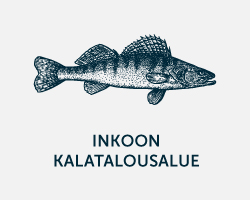Fishing regulations
National fishing legislation
Check the national catch sizes, catch quotas and closed seasons here.
It is the fisher’s responsibility to check prohibitions and restrictions before going fishing. The fisheries management fee does not entitle you to fish in rapids and currents in waters with migratory fish, at sites requiring a site-specific permit, or at sites where fishing is entirely prohibited. You can check these at the web site Kalastusrajoitus.fi.
Local fishing regulations
In addition to national restrictions and regulations, the fisheries region has its own local fishing regulations. The following fishing regulations are in force within Inkoo fisheries region:
Högbenssjön
- Minimum catch size for pikeperch: 45 cm.
- Catch quota: 1 pikeperch per angler per day (does not apply to net fishing).
- The minimum permitted mesh size (knot-to-knot) is 50 mm (does not apply to nets used for catching baitfish).
- Fishing is prohibited from May 15 to June 15 throughout the entire lake, with the exception of angling, rod fishing from the shore, or any authorized stock management measures.
- To protect the spawning of pikeperch.
Year-round – Rapids and currents of the Ingarskila River system, including the Solberga River
All fishing is prohibited.
To protect the sea trout.
15 May – 15 June – Kyrkfjärden, Innanbäckviken, Svenviken, Fagerviken and Nötöfladan
All fishing is prohibited except angling from the shore.
To protect the spawning of pikeperch.
1 August – 31 December – Ingarskila River system, including the Solberga River
Fishing with nets, fish traps, and fyke nets is prohibited.
To protect the sea trout.
1 September – 30 November – Coastal waters outside the Ingarskila River
All fishing is prohibited.
To protect the sea trout.
For more detailed information about the restricted areas, please visit Kalastusrajoitus.fi
In addition, the fisheries region recommends using a minimum mesh size of 50 millimetres in nets taller than 1.8 metres.
This recommendation helps safeguard the pikeperch population by giving the fish time to spawn prior to being caught, promoting long-term sustainability.
!! Please note that if you are fishing with permission from the owner of the water area (local permit), the regulations might be even stricter than the national and fisheries region ones. The local permit seller will inform you about their own regulations.!!
Handling Fish Properly
When keeping fish for food, regulations require they be killed quickly and humanely. A recommended method is to first stun the fish with a firm blow above the eyes, then bleed it by cutting the gill artery. Small fish can often be killed by bending the neck.
Fish that are undersized, protected, or otherwise released must be handled gently to prevent injury and give them the best chance of survival. Avoid touching the fish and minimize the time it spends above water. Unhook it quickly and carefully and release it back as soon as possible. Barbless hooks and smooth, knotless nets help reduce harm.
Even if an undersized or protected fish is injured, it must not be kept. If the fish is badly hurt and unlikely to survive, it must be killed before being released to prevent unnecessary suffering.
